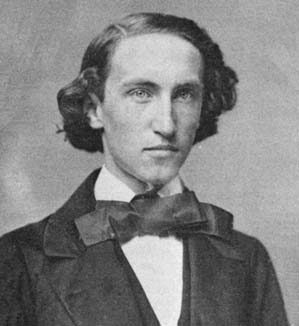<Back to Index>
- Physicist, Chemist and Mathematician Josiah Willard Gibbs, 1839
- Photographer William Henry Fox Talbot, 1800
- Governor of Greece (Κυβερνήτης της Ελλάδας) Ioannis Kapodistrias, 1776


Josiah Willard Gibbs (February 11, 1839 – April 28, 1903) was an American theoretical physicist, chemist, and mathematician. He devised much of the theoretical foundation for chemical thermodynamics as well as physical chemistry. As a mathematician, he invented vector analysis (independently of Oliver Heaviside). It is in good part thanks to Gibbs that much of physical and chemical theory has since been exposited using vector analysis. Yale University awarded Gibbs the first American Ph.D. in engineering in 1863, and he spent his entire career at Yale.
In
1901, Gibbs was awarded the highest possible honor granted by the
international scientific community of his day, granted to only one
scientist each year: the Copley Medal of the Royal Society of London, for his greatest contribution, that being "the first to apply the second law of thermodynamics to the exhaustive discussion of the relation between chemical, electrical, and thermal energy and capacity for external work." Gibbs was the seventh in a long line of American academics stretching back to the 17th century. His father, a professor of sacred literature at the Yale Divinity School, is now most remembered for his involvement in the Amistad trial. His mother was the daughter of a Yale graduate in literature. After attending the Hopkins School, Gibbs matriculated at Yale College at the age of 15. He graduated in 1858 near the top of his class, and was awarded prizes in mathematics and Latin. In 1863, Gibbs was awarded the first Ph.D. degree in engineering in the USA from the Sheffield Scientific School at Yale. He then tutored at Yale, two years in Latin and one year in what was then called natural philosophy,
now comparable to the natural sciences, particularly physics. In 1866
he went to Europe to study, spending a year each at Paris, Berlin, and Heidelberg, where he was influenced by Kirchhoff and Helmholtz. In 1869, he returned to Yale and was appointed Professor of Mathematical Physics in
1871, the first such professorship in the United States and a position
he held for the rest of his life. The appointment was unpaid at first,
a situation common in Germany and otherwise not unusual at the time,
because Gibbs had yet to publish anything. Between 1876 and 1878 Gibbs
wrote a series of papers on the graphical analysis of multi-phase
chemical systems. These were eventually published together in a
monograph titled On the Equilibrium of Heterogeneous Substances, his most renowned work. In these papers Gibbs applied thermodynamics to
interpret physicochemical phenomena, successfully explaining and
interrelating what had previously been a mass of isolated facts. In 1880, the new Johns Hopkins University in Baltimore, Maryland offered
Gibbs a position paying $3000. Yale responded by raising his salary to
$2000, and he did not leave New Haven. From 1880 to 1884, Gibbs
combined the ideas of two mathematicians, the quaternions of William Rowan Hamilton and the exterior algebra of Hermann Grassmann to obtain vector analysis (independently formulated by the British mathematical physicist and engineer Oliver Heaviside). From 1882 to 1889, Gibbs refined his vector analysis, wrote on optics,
and developed a new electrical theory of light. He deliberately avoided
theorizing about the structure of matter, a wise decision in view of
the revolutionary developments in subatomic particles and quantum mechanics that
began around the time of his death. His chemical thermodynamics was a
theory of greater generality than any other theory of matter extant in
his day. After 1889, he worked on statistical mechanics, laying a foundation and "providing a mathematical framework for quantum theory and for Maxwell's theories". He wrote classic textbooks on statistical mechanics, which Yale published in 1902. Gibbs also contributed to crystallography and applied his vector methods to the determination of planetary and comet orbits. Gibbs
never married, living all his life in his childhood home with a sister
and his brother-in-law, the Yale librarian. His focus on science was
such that he was generally unavailable personally. Gibbs died in New Haven and is buried in Grove Street Cemetery.
Gibbs also wrote on theoretical thermodynamics. In 1873, he published a paper on the geometric representation of thermodynamic quantities.